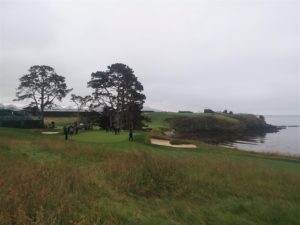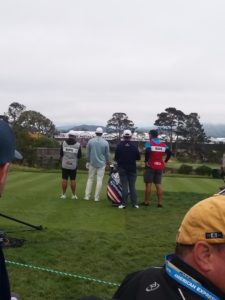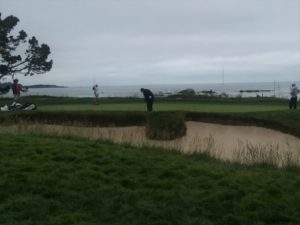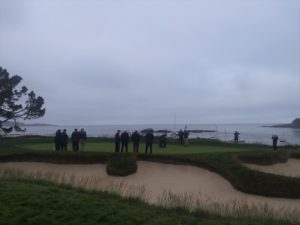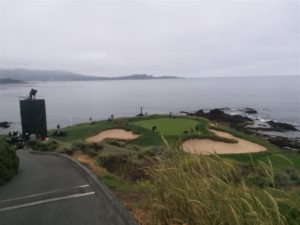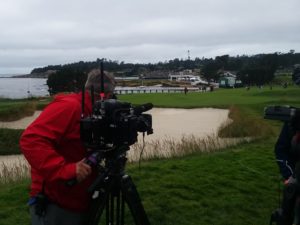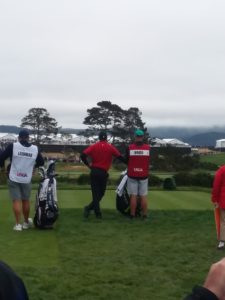
With that purpose in mind, I arrived at Pebble Beach Golf Links at five thirty last Sunday morning and was among the first dozen fans in the gates at six for the final day of the 2019 US Open Golf Championship. The course was alive with an army of grounds crew preparing the greens, bunkers, and fairways for the first tee-off set at seven twenty-one, according to the schedule I received upon entry. The cart traffic on the paths was so heavy that I kept looking behind me to make sure I didn’t get run over. The air was cold with a slight drizzle, a contrast to the dry summer heat of Redding that I had left the day before.
I stopped at the green on the fourth hole, the first one on the course that lay along the ocean. On the advice of a fan there before me, set my chair up to the rope where I could see the green as well as the fifth tee a few feet to my left. A deep, carefully raked bunker sat between me and the putting surface, while a yacht, a sailboat and several smaller craft sat in the water just beyond the other side. The fourth fairway extended to my right, and in the distance I could see the third green just beyond the fourth tee. This spot was as good as I was going to get, and I was grateful that my planning and luck had worked out to such perfection.
I soon found that fans could leave their chairs and return without having their spots taken, similar to the practice at the Masters Tournament, so in addition to finding rest rooms (vital information for an all-day event), I ventured up the fifth and sixth holes along the ocean to the seventh tee, which overlooked the famous green a mere hundred yards away on the edge of the water. I had considered watching the tournament there, and the grandstands nearby often filled up before any of the others, but with the relatively calm breeze I figured that the hole would not offer the same drama as when the wind kicked up to twenty or thirty miles per hour, challenging even the best golfers to keep their balls from drifting into the ocean. A couple of fans extended a phone to me and asked for a picture, a life moment I was happy to record.
Back at my chair, I made acquaintances with the other early birds as we waited for the players to arrive. The fan who had advised me was a regular at major tournaments, including several Masters and an Open at St. Andrews. He pulled out his phone and showed me a food menu from the most recent Masters. The prices, none of which topped four dollars even for the most expensive items, seemed out of the Eisenhower Era, which aligned with just about everything else about Augusta National, where even cell phones were forbidden on the course to all including club members. The US Open had a freer atmosphere, forbidding cameras but allowing phones, but in the early hours it still had a feeling of historic tradition. People spoke quietly and reverently, with plenty of staff and uniformed marshals patrolling the area to ensure that no one misbehaved.
The first player showed up about eight o’clock, an amateur named Michael Thorbjornsen who had barely made the cut on Friday and then shot an 84 on Saturday, sitting at 15 over par to begin on Sunday. The hole was a short par four at 324 yards, driveable from tee to green for the longer hitters on the PGA Tour, but Thorbjornsen, like most of the players on Sunday, teed off with an iron and laid up about a hundred yards from the hole, avoiding the bunkers around the green and allowing for a wedge approach shot that many players found easier to control than a pitch or a chip. This strategy unfortunately failed for Thorbjornsen, who hit his approach into the right bunker and ended with a bogey.
Most players were more fortunate, routinely reaching the green with the regulation two strokes. The green sloped back to front, and it was soon evident that players preferred to putt uphill from the front rather than downhill, where it was much harder to control the distance and judge the break; a gentle tap of the ball from fifteen feet out could easily slide past the cup by several feet, leaving a challenging return putt for par. The surfaces, notoriously fast in US Open play, were a little more forgiving in the morning with the drizzle keeping the grass moist, unlike later in the day when they dried out and became more like putting on concrete.
The control that the players exerted on their shots was a sight to behold. Their approaches, full of back-spin, bit hard on the green and often rolled back a few feet. Nor did the bunkers or roughs deter them to any great extent; those who hit out of those spots routinely got their balls close enough for makeable putts. Good short games came in handy at Pebble Beach. Its greens are among the smallest on the Tour.
The best demonstration of such came when Phil Mickelson showed up. Everyone watched carefully for him, and eventually he appeared in his familiar black Sunday outfit on the third green. A player universally known on a first-name basis by adoring fans, Mickelson had a reputation not just for the quality of his play but for its drama as well. No shot was too risky for him, and if it went into a bunker or off into the weeds, he could always rely on his renowned short game to bail himself out of trouble. As one might have expected, he tried to drive his ball onto the green and ended up over the cliff toward the water. Red-vested marshals searched for his ball for several minutes, but eventually he took his drop sixty yards from the hole and pitched his ball onto the left edge of the green about even with the hole. He had turned 49 that day, and fans sang Happy Birthday as he walked onto the green. I sat almost directly behind him as he lined up a 26-foot putt with a significant sideways slope. He then nailed it as the ball broke at least three feet on its way to the cup, saving par for the hole. The crowd roared its approval. I had witnessed the essence of Phil’s career in a moment, and if I had seen nothing else that day, it alone was worth my effort and expense, and I will take it to my grave.
A crowd had formed behind our chairs by then, and it was easy to gauge the popularity of the players by the sound of the comments I heard as they approached. One who was decidedly unpopular was Patrick Reed, winner of the 2018 Masters, famously estranged from his family and temperamental on the course. On Saturday, he had snapped his wedge in two on the 18th green. He hit his approach shot within six feet downhill from the cup, then missed his putt for birdie. As he waited for his playing partner to finish, he crossed his arms and looked every bit as angry as he had been on the previous day. A lot of people behind me rooted quietly for him to break his putter as he had his wedge, but he managed to restrain himself.
One fan directly behind me provided a lot of entertaining commentary. Another veteran of major tournaments, he had come from Memphis for the occasion. One of his friends came by with a big bag of merchandise. “Did you leave anything in the store?” he asked. Later, when one of many putts that day missed the cup, “They never go in. I should know. I haven’t made a putt since the Nixon Administration.” His favorite player was Jason Dufner, winner of the 2013 PGA and one of the few players that day who sported a thick midsection. “Lots of sweet tea,” the Memphis fan said. “Doesn’t miss any meals. Doesn’t give a shit. He’s great.”
Tiger Woods teed off just before noon, and there was no mistaking his approach about forty minutes later. His army of followers appear, most straining to get a glimpse of him in his familiar Sunday red shirt and black Nike cap. Additional cameramen descended upon the green to get shots of him as he walked up the fairway. Tiger laid up his first shot then hit his approach a little short, with the ball landing about even with the hole but back-spinning off the front of the green. I learned later that such was typical of him not just of that day but the entire tournament: a lot of shots left short, reflecting a tentativeness that suggested a lack of confidence despite his recent Masters victory. In this case, the damage was light. Tiger chipped his ball to within a foot from the hole and tapped his ball in for a routine par.
I was able to see Tiger’s face pretty clearly as he walked from the green to the fifth tee a few feet away. It looked a bit weathered, more so than what normally shows up on TV. I noticed the same thing with Phil, and though both of them are over 40, it occurred to me that they and just about everyone else on the Tour have spent as much of their lives outside as farm laborers, and as good as life may be off the course, all that time in the sun and the elements takes its toll on your complexion.
By then, I started to feel a little worn myself despite being one of the privileged few with a chair. I had not anticipated how long it would take for an entire set of forty player pairs to cycle through the course. I had been at my spot for six hours by the time Tiger appeared, fortunately with rest room and concession breaks, and the last pair with the tournament leaders wasn’t scheduled to tee off for another two hours. Adding to the discomfort was the chill that eventually sunk through my clothing–the temperature never broke sixty all day. I wore a long-sleeved shirt and a sweatshirt, and the cold was just tolerable if I kept my hood over my head. It occurred to me that attending a golf tournament was a fan’s equivalent of running a marathon, not for the faint of stamina. Fortunately, this was the time that the true contenders started to appear, which helped me to keep my interest in the proceedings.
One of them, Dustin Johnson, played himself out of contention as I watched. Using his driver in the hopes of making the green, he sliced his ball over the cliff not far from where Phil had hit. Taking his drop about seventy yards out, he hit onto the back of the green and left himself a downhill putt more than thirty feet from the cup, exactly what he had hoped to avoid. His first putt ran past the hole about six feet, and his second lipped out of the cup, leaving him with a double bogey six. He was one of the more popular players in the tournament, and the crowd groaned with his miss and seemed to feel his pain as he departed.
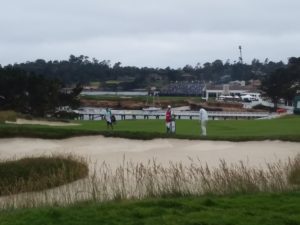
It turned out to be a two-man competition for the championship. The winner of the PGA Tournament just the month before, Brooks Koepka, was in the second to last pair. He started the day at seven under par, four shots off the lead, and promptly birdied two of the first three holes to start a run up the leaderboard, which we could see about halfway up the fairway. Though he is one of the longest hitters on the Tour and has plenty of upper body muscle to explain why, he chose to lay up his drive on the fourth hole about ninety yards out. Then, he hit his approach shot five feet above the hole and nailed his putt for birdie. Nothing to it, and it was easy to see why he had won not only the recent PGA but also the two previous US Opens. He seems a sure bet to be a regular presence on leaderboards over the next few years, and with four major victories on his resume at age 29, a challenge to Tiger or even Jack Nicklaus for career totals does not seem out of the question.
As often happens at US Opens, however, the day belonged to a first-time winner, Gary Woodland. Starting his day at eleven under, he quickly birdied holes one and three to extend his lead, then played steady par golf for the rest of the way to finish three strokes ahead of Koepka. At 35, he had to wait a long time for his first major victory, his best previous major finish being sixth in the 2018 PGA. I was happy for him to have seized perhaps his one lifetime moment in the spotlight, refusing to wilt under the pressure like so many other first-time leaders in a major. It’s hard to say whether he’ll have another opportunity. The history of golf is littered with one-and-dones, but even if such is his fate, he has a trophy and a glorious moment that no one will ever take away.
I was long gone by the time Woodland finished on eighteen. With the crowd at its peak by the time he finished on four, I knew I would not get anywhere near the action from that time forward, so I went back to the Trophy Club, a tent with big-screen TVs and upgraded concessions and restrooms, a privilege for which I had paid an extra hundred dollars when I bought my ticket, thinking it would be worth it at the time. After about twenty minutes to justify my investment, I bought a T-shirt in a merchandise tent the size of a Wal-Mart, got on the shuttle back to my car at CSU Monterey–17 Mile Drive was closed for the week–and was home about six hours after that, exhausted after a day that had started before four that morning. I enjoyed myself as much as humanly possible, but I’m not sure I’ll ever go to a major golf tournament again, since such would demand expensive flights and hotels, both of which I was able to avoid on this occasion due to my daughter happening to live about ten minutes from the shuttle stop. If I do attend another, it will be the next US Open at Pebble, only eight years off in the year 2027. For those who are interested, you are free to stay tuned.
